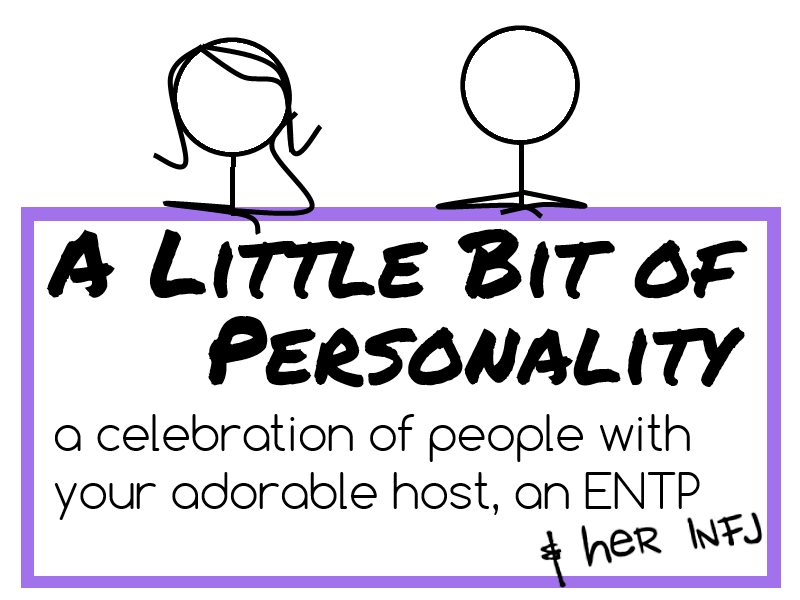Hi! If this is your first time visiting A Little Bit of Personality (aLBoP as we like to call it in endearing tones), welcome!! I’m Calise and I’m *sooo* super excited to share this introductory, condensed, no-frills version of how people think and how to use that information to understand yourself and everyone around you!
The purpose of this series is to explain as crash-course-ly as possible the basic building blocks that form the 16 types of cognition. No prior understanding of cognition, psychology or personality types required (though a basic understanding of people, decent reading comprehension and a certain level of human decency are all requested). There will of course be many pictures. 😀
If you *do* have previous experience with personality typing you might need to check it at the door as you’ll probably find what we do here at aLBoP to be quite different than 99.9% of personality typing in the world.
What we do here on aLBoP is Cognitive Typing, understanding people based on how their minds work; most personality typing is Behavioral Typing, typing people based on their behaviors. Cognition has a massive effect on decisions and behaviors, but what you *do* is not the same thing as the thought process behind *why* you did it in the first place.
If you stick around aLBoP you’ll see what I mean; we talk about it kind of a lot. Here’s a video for example. But you don’t need to know about that yet! The point is, if you do a quick internet search expecting other sites to be like aLBoP, you might be shocked to see how different their approach is from ours. And while there are plenty of well-intentioned behavioral books and websites out there, there are also a plethora of ones who end up oversimplifying and demeaning humanity on the whole, so don’t say I didn’t warn you! 😉
So what exactly is Cognition?

“Cognition” is simply the action of your mind acquiring and processing information.
Obviously, since your understanding of the entire world and everything and everyone in it is based on the information you’ve already acquired and processed, combined with new information you acquire and process, cognition is important.

As you come to understand what’s already going on inside your head, you can see how to do it better and on purpose, see where your understanding of the world around you has been hiccupping and messing things up in your life, help you see where others are coming from and why different ways of thinking are valid, and be happier with yourself as you work with your thought process instead of against it. It literally never stops applying.
The Four Types of Information
When you think, your mind automatically does 4 things:

Data & Details: Analyzing situational information in order to ask questions and make conclusions.

Principles & Trends: Compiling an understanding of the world as a whole in order to understand universal trends.

Actions & Consequences: Watching the consequences of actions in order to make decisions and plans.

Observation & Motivations: Observing individuals as whole entities in order to make character judgments and explore possibilities.
Everyone does all four, but our minds prioritize them in different orders based on what we want most, deep down, and how important each type of information is to us personally. All four are equal in overall worth and intelligence, but there is just too much information in the world for a single mind to prioritize them all!

Actually, all cognition types are, are observations of how different people prioritize and process these Four Types of Information and the natural results thereof. Let me demonstrate…

The Perceiving half of the cognition process is made up of Data & Details, and Observation & Motivations. Perceiving focuses on possibilities of action and how individuals and situations interact.
Perceivers (P) use this half of the cognition process first.

The Judging half of the cognition process is made up of Principles & Trends, and Actions & Consequences. Judging focuses on plans of action and how the world and consequences interact.
Judgers (J) use this half of the cognition process first.
As natural results of prioritizing these types of information, Judgers like to plan and act first, while Perceivers like to explore and respond.

Now, the reason the Four Types of Information are effective as a method of understanding people and the way they think is that they’re a combination of two dichotomies; or a double-dichotomy as I like to call it! (If you Google double dichotomy the only results are some Catholic proof thing… that’s not what we’re talking about 😉 )
A dichotomy is made of two opposite variables that have no overlap. The example Justin used here was things that are red and things that are not red; that’s a dichotomy.
A double-dichotomy, as I use it, is a pair of independent but related dichotomies that can be used together to cover all the options.
For example, if you had one dichotomy of things that are red vs. things that aren’t, and paired that up with the second dichotomy of things that were round vs. things that were not round, everything in existence would fit into one of the four resulting categories. So a red bouncy ball and red apples would fit into the red and round category, while yellow hula hoops and soccer balls (footballs ;)) would fit into the not red, but round category. Quintessential fire trucks would fit into the red and not round category, and frogs and brown books would fit into the neither red nor round category.

(This picture was ridiculously harder and more time consuming than any other in this post… and most on aLBoP. I’m still getting over resentment of frogs and fire trucks. -_-)
Using two dichotomies in relation to each other makes the resulting data more specific and helps us spot more complex trends at the same time, whereas just one dichotomy can oversimplify the results.
Obviously though, those particular two dichotomies (red and round), aren’t super applicably useful or even especially balanced. Whether something is red or round doesn’t tell us anything about if it’s even alive or how big it is or anything, and there are way more things in the world that are neither red nor round than there are any of the other three groups.
In order to be useful in practice with something as complex as human cognition, the double-dichotomy we use has to be both pretty straightforward, without a lot of frills to the definition, and universally encompassing.
Long story short, this leads us to the rock-awesome double-dichotomy that is the Four Types of Information.
The first dichotomy variable is Information vs. Action.

The Information half of the cognition process is made up of Data & Details, and Principles & Trends. Information focuses on understanding the way things are.
Psychological Introverts (I) focus on Information first in the cognition process. Introverts also focus on Data & Details before Observation & Motivations while perceiving.

The Action half of the cognition process is made up of Action & Consequences, and Observation & Motivations. Action focuses on understanding what people do.
Psychological Extraverts (E) focus on Action first in the cognition process. Extraverts also focus on Observation & Motivations before Data & Details while perceiving.
**Essential clarification!** Psychological Introversion and Extraversion are not the same as social introversion and extroversion.

Instead, psychological Introversion and Extraversion are about where you look first for information. Introversion looks first inside the mind to understand the way things are (Information), and Extraversion looks first outside at what people do (Action).

The other dichotomy variable in our double-dichotomy is Specific vs. Universal.

The Specific half of the cognition process is made up of Data & Details, and Actions & Consequences. These types of information focus on understanding the Specific applications of information for a more zoomed-in perspective.
IPs and EJs (we sometimes call “Specifics”) focus on Specific information first in the cognition process. All IPs and EJs focus on Action & Consequences before Principles & Trends while judging.

The Universal half of the cognition process is made up of Principles & Trends, and Observation & Motivations. These types of information focus on understanding the Universal Patterns of information for a more zoomed-out perspective.
IJs and EPs (we sometimes call “Universals”) focus on Universal information first in the cognition process. All IJs and EPs focus on Principles & Trends before Action & Consequences while judging.
As a result of prioritizing these types of information, IPs and EJs start with specifics and find the big-picture from those specifics, while IJs and EPs start with the big-picture and find specifics from that big-picture. We all do both, just in different orders. When healthy both are equally good and equally needed.

It’s okay if you’re not sure which type of information your mind prioritizes the most, yet. So far we’ve only covered 4 different kinds of cognition, and you might remember that I said there are 16 unique cognition processes. Well in the next installment of aLBoP’s Cognition – The Super Simple Series we’ll talk about Functions and their effect on cognition, and then in Part 3 we’ll combine what we’ve learned to see how the Four Types of Information and the four Functions combine to form Cognition Steps!
So that leads us to Part 2: The Four Functions… Coming soon! (Sooner if you Like, share, comment, sub, and Patreon!) Thanks for reading!!
Oh, and here’s the whole post in picture form, for pinning, tumbling, tweeting, etc. 😀
On the aLBoP Guided Tour? This is the first stop 🙂 Super Simple Part 2: The Four Functions is up next!



















Yay! I’m rereading. 😀 It’s really cool watching the stuff be put together step by step. And I think (double)dichotomies are pretty exciting to think about, haha
Wow the information you present here is really very easy to understand and plus the pictures are very informative (and very emotional, less like a robot explaining, it feels pretty much natural) Thank you for sharing this !
Lots of support from a random ENFJ reader
Never mind I got it. I was confused because you wrote that IPs and EJs focus on specific information (instead of writing specific types of information) I got it now. It threw me off because of information being used as Specific information/Universal information as well as being used for all four types of information.
Just a question. So there’s two dichotomies. One is specific and universal. The other is information and action. You said that IPs and Ejs focus on specific information first and then the focus on specific action before they look at trends and principles. Why Do you put IPs and EJs on the specific dichotomy and IJs and EPS on the Universal dichotomy? Wouldn’t there be a group on the information dichotomy and another on the Action dichotomy as well?
Takes a while to digest and not mistake one with the other, and understand the combination, but slowly gets in!
Loved the pics. Next timed don’t waste time drawing a firetruck and use a premade one, haha.
Thanks a lot.
Wow! I love how all this stuff fits together so well and makes so much sense!
I love, LOVE this blog. Your explanations are simple, yet knowledgeable. The stick figures are adorable and so is your personality that shines through every word.
Awesome explanation! This clearly cuts through the stereotypes of Judgers vs Perceivers and Introverts vs Extroverts and shows the real ways they are both different and similar to each other.